Genital mycoplasma infection: a systematic review and meta-analysis
- PMID: 37700294
- PMCID: PMC10496402
- DOI: 10.1186/s12978-023-01684-y
Genital mycoplasma infection: a systematic review and meta-analysis
Abstract
Background: Recent studies have suggested that genital mycoplasma infections may be associated with male infertility. However, this association remains controversial due to time lapse, sample size, and regional prevalence.
Objectives: This study aimed to systematically evaluate the relationship between genital mycoplasma and male infertility through a meta-analysis and to provide a basis for the clinical management of male infertility.
Methods: We conducted a search on PubMed, EMBASE, the Cochrane Library, and CNKI databases, from January 2000 to June 2023 to identify case-control studies on the interrelationship between genital mycoplasma infection and male infertility. Two independent researchers performed an assessment of the methodological quality of trials according to the Newcastle-Ottawa scale and extracted data strictly based on the inclusion and exclusion criteria, and afterward, we carried out a meta-analysis using Stata 16.0. Pooled odds ratios (OR) with 95% confidence intervals (CI) were used to assess this relationship.
Results: This meta-analysis included 21 studies from seven countries with a total of 53025 infertility cases and 6435 controls; the age range of the participating men was from 20 to 59 years old. The results obtained showed a higher prevalence of M. genitalium, M. hominis and U. urealyticum infections in infertile men than in the controls, with the opposite result for U. parvum (M. genitalium, OR, 3.438 [95% CI: 1.780, 6.643], with P = 0.000; M. hominis, OR, 1.840 [95% CI: 1.013, 3.343], with P = 0.045; U. urealyticum, OR, 3.278 [95% CI: 2.075, 5.180], with P = 0.000; U. parvum, OR, 1.671 [95% CI: 0.947, 2.950], with P = 0.077). Further, two subgroup analyses also showed that M. hominis and U. urealyticum infections were strongly associated with male infertility in China (M. hominis, P = 0.009; U. urealyticum, P = 0.000); however, M. hominis and U. urealyticum infection was not strongly associated with male infertility worldwide (M. hominis, P = 0.553; U. urealyticum, P = 0.050).
Conclusion: This meta-analysis revealed that male infertility was significantly associated with M. genitalium, M. hominis and U. urealyticum infections, while U. parvum infection was not. Further, our study showed that genital mycoplasma infection influences male infertility and provides a basis for future treatment.
Keywords: Genital mycoplasma; Infection; Male infertility; Meta-analysis; Systematic review.
© 2023. BioMed Central Ltd., part of Springer Nature.
Conflict of interest statement
The authors declare that they have no competing interests.
Figures
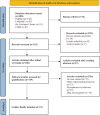
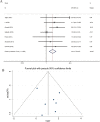
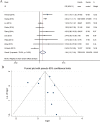
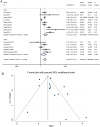
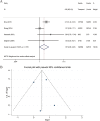
Similar articles
-
Mycoplasma and ureaplasma infection and male infertility: a systematic review and meta-analysis.Andrology. 2015 Sep;3(5):809-16. doi: 10.1111/andr.12078. Andrology. 2015. PMID: 26311339
-
Systemic pharmacological treatments for chronic plaque psoriasis: a network meta-analysis.Cochrane Database Syst Rev. 2021 Apr 19;4(4):CD011535. doi: 10.1002/14651858.CD011535.pub4. Cochrane Database Syst Rev. 2021. Update in: Cochrane Database Syst Rev. 2022 May 23;5:CD011535. doi: 10.1002/14651858.CD011535.pub5. PMID: 33871055 Free PMC article. Updated.
-
Systemic pharmacological treatments for chronic plaque psoriasis: a network meta-analysis.Cochrane Database Syst Rev. 2017 Dec 22;12(12):CD011535. doi: 10.1002/14651858.CD011535.pub2. Cochrane Database Syst Rev. 2017. Update in: Cochrane Database Syst Rev. 2020 Jan 9;1:CD011535. doi: 10.1002/14651858.CD011535.pub3. PMID: 29271481 Free PMC article. Updated.
-
Antioxidants for male subfertility.Cochrane Database Syst Rev. 2022 May 4;5(5):CD007411. doi: 10.1002/14651858.CD007411.pub5. Cochrane Database Syst Rev. 2022. PMID: 35506389 Free PMC article.
-
Intravenous magnesium sulphate and sotalol for prevention of atrial fibrillation after coronary artery bypass surgery: a systematic review and economic evaluation.Health Technol Assess. 2008 Jun;12(28):iii-iv, ix-95. doi: 10.3310/hta12280. Health Technol Assess. 2008. PMID: 18547499
Cited by
-
Mycoplasma genitalium Infections and Associated Antimicrobial Resistance in Canada, 1980-2023.Trop Med Infect Dis. 2025 May 19;10(5):139. doi: 10.3390/tropicalmed10050139. Trop Med Infect Dis. 2025. PMID: 40423368 Free PMC article.
-
Mycoplasma genitalium infection in Eswatini amid syndromic case management: prevalence, coinfections, diagnostic challenges and treatment gaps.BMC Infect Dis. 2025 Apr 17;25(1):547. doi: 10.1186/s12879-025-10944-0. BMC Infect Dis. 2025. PMID: 40247214 Free PMC article.
-
A genome-wide investigation of Mycoplasma hominis genes associated with gynecological infections or infertility.Front Microbiol. 2025 Apr 30;16:1561378. doi: 10.3389/fmicb.2025.1561378. eCollection 2025. Front Microbiol. 2025. PMID: 40371111 Free PMC article.
-
Prevalence of Mollicutes in pregnant women undergoing high-risk prenatal care at a maternal and child reference unit in Bahia, Brazil.Epidemiol Infect. 2025 Jun 25;153:e73. doi: 10.1017/S0950268825100137. Epidemiol Infect. 2025. PMID: 40556319 Free PMC article.
-
Emerging antimicrobial resistance and high prevalence of genital Mycoplasma hominis and Ureaplasma urealyticum infections among infertile women in Algeria : Implications for reproductive health.Wien Klin Wochenschr. 2025 Jul 23. doi: 10.1007/s00508-025-02569-9. Online ahead of print. Wien Klin Wochenschr. 2025. PMID: 40699317
References
Publication types
MeSH terms
Grants and funding
LinkOut - more resources
Full Text Sources
Medical

